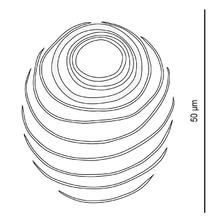Squamodisc


Squamodiscs are epidermal structures, which are typical of and found only in certain monogeneans of the family Diplectanidae. There are, typically, two squamodiscs, one ventral and one dorsal, located on the haptor of the monogenean. Squamodiscs are usually made up of scales embedded in the epidermis, which appear from the outside as rodlets arranged in rows.[2]
According to the classical book of Bychowsky (1967),[3] “the Diplectanidae] have special paired attaching formations lying above the disc and also partially on it, on the dorsal and ventral sides in the shape of small rounded convexities equipped with numerous [...] thorn-shaped little hooks or thin thread-like plates located more or less in concentric rows ("squamodisc")".
Ultrastructural studies of squamodiscs [4][1] have shown that they include epidermally-embedded spines which are covered by the outer epidermal membrane. The spines are composed of a moderately electron-dense material with denser fibrils embedded within it.
A diplectanid genus Squamodiscus Yamaguti, 1934 was created but is now considered[5] a synonym of Diplectanum Diesing, 1858.
Some diplectanids, such as members of the genera Lamellodiscus or Calydiscoides, have a similar structure which is composed of lamellae, not rodlets; in this case the structure is called a lamellodisc.[2]
References[]
- ^ a b Knoff, Marcelo; Cohen, Simone Chinicz; Cárdenas, Melissa Querido; Cárdenas-Callirgos, Jorge M.; Gomes, Delir Corrêa (2015). "A new species of diplectanid (Monogenoidea) from Paranthias colonus (Perciformes, Serranidae) off Peru". Parasite. 22: 11. doi:10.1051/parasite/2015011. PMC 4353888. PMID 25754099.

- ^ a b Oliver, Guy. "Les Diplectanidae Bychowsky, 1957 (Monogenea, Monopisthocotylea, Dactylogyridea). Systématique. Biologie. Ontogénie. Écologie. Essai de phylogenèse". doi:10.6084/M9.FIGSHARE.1295274. Cite journal requires
|journal=(help) - ^ Bychowsky, B. E. (1957) Monogenetic Trematodes. Their systematic and phylogeny. Akad. Nauka. USSR. English translation by the American Institute of Biological Science, Washington. 509 pp.doi:10.5962/bhl.title.7475

- ^ Shaw, M. K. (2009). "The ultrastructure of the pseudohaptoral squamodiscs of Diplectanum aequans (Monogenea)". Parasitology. 82 (02): 231. doi:10.1017/S0031182000056961. ISSN 0031-1820.
- ^ Yamaguti, S.(1963). Systema Helminthum Volume IV Monogenea and Aspidocotylea: John Wiley & Sons.
- Platyhelminth anatomy
- Animal morphology
- Parasitic protostomes
- Monogenea
- Monopisthocotylea
- Diplectanidae
